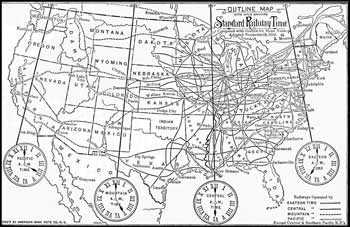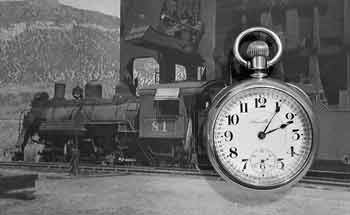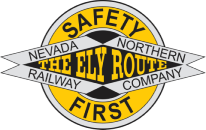Spring forward, fall back, twice a year we go through this time gyration. After we spring forward, when someone asks the time, “We’ll say it is 11:00 am Pacific Daylight Time.” And in the fall, “We would say it is 11:00 am Pacific Standard Time.” But why do we say standard time? The answer really has nothing to do with daylight savings time. In fact, standard time predates daylight saving time by 35 years. Confused?
To quote the band Chicago, “Does anybody really know what time it is? Does anybody really care?”
Well believe it or not, once upon a time, people really didn’t care what time it was. Time standards did not exist! The need for standardization became readily apparent with the invention of the steam locomotive and the building of railroads, but why?
Before railroads, people used local or solar time. In other words, every town had a person who went outside, checked out when the sun was at its highest point in the sky and cried out, “It is noon!” And everyone agreed.
Local time worked great for an agricultural society. And because people walked or rode a horse going from one town to another, the difference in time didn’t matter. The coming of industrialization and the iron horse created the need for a standard time.
Railroading changed everything. If you built a railroad that ran north south, time wasn’t an issue. All of the towns along your line had the same time. But if you built an east-west railroad, you had problems because every town along your line had a different time!
The completion of the transcontinental railroads at Promontory, Utah on May 10, 1869 illustrated the problem. The building of the transcontinental railroad was the largest construction project of its day. Now two bands of steel would join the eastern and western United States joining the nation.
The nation waited with bated breath for the magic moment when the last spike would be driven home. The spike maul to be used and the last spike were wired to the telegraph line. When the maul struck the spike, the exact moment in time of the completion of the transcontinental railroad would be transmitted along telegraph lines to reporters waiting in cities and towns across the entire nation!
Leland Stanford, President of the Central Pacific Railroad, raised the maul to drive the last spike to complete the railroad. When he hit the last spike, the announcement would be telegraphed to the nation. Stanford swung the spike maul and MISSED! But an eager telegrapher relayed the message, “Done!”
The moment was recorded, but with no time standards in place, the time the last spike was driven was reported in accordance with local time across the country: 12:45 p.m. at Promontory, 12:30 p.m. in Virginia City, both 11:44 and 11:46 a.m. in San Francisco, and 2:47 p.m. in Washington D.C.
Here was the completion of the largest construction project that the nation had ever undertaken, and the time of the completion depended on where you were at the time. Time was confusing.
Additionally, collisions between trains happened because of the inability to agree what time it was. In August, 1853 there was a fatal head-on collision between two trains. The reason was the two conductors of the different trains were using two different times. This collision was the catalyst that started the railroads on the path of standardizing time.
Over the next several decades, U.S. railways adopted their own standardized times, allowing them to maintain an accurate schedule. However, there were more than 50 railway times and over 8,000 local times. Stations displayed multiple clocks showing the local time and the times for the various railroads.
To put that in perspective for today, imagine flying from San Francisco to New York City with the need to change planes in Chicago. Your ticket on United Airlines is for a 2:15 pm departure, but the local time in San Francisco is 12:47 pm. And you arrive in Chicago at 6:45 pm United time, but Chicago time is 6:38 pm and your Delta flight leaves at 8:00 pm Delta time which is 6:52 pm Chicago time, so you have 14 minutes to make your flight. And your smart phone shows Verizon western time which is not the same as AT&T, Sprint or T-Mobile time, but that’s OK, because there is an app for that. Confused?
It was all very confusing. The people who could and would get confused were locomotive engineers, train conductors and train dispatchers. Their confusion did lead to tragic results from trains crashing into one another. A train cannot pull over like an automobile. Once a train is on a track, there is no way for a train to pass another train except by using a side track. And in the days before smartphones, telephones or telegraph, the only way to control trains was with time. And if the time wasn’t standardized, then accidents happened and people died.
In the late 1860s, Charles Ferdinand Dowd developed the first comprehensive, practical plan for time standardization in the United States. He was not a railroad man, but he developed his interest in timetables and time standards as a teacher posing a problem to his students. In 1869, he wrote his first standard for Railway Time.
Dowd’s original concept was to create one time zone, like Great Britain, using Washington, D.C. as the national meridian. All railroad clocks would be set from this national meridian. The problem with this idea was the United States was considerably larger from east to west than Great Britain. Using Washington D.C. as the national meridian for time would mean there would be a sizeable difference between local time and railroad time on the west coast.
Dowd sought a more neutral location and recommended Greenwich Mean Time. In 1873, a group of railroad managers and supervisors came together at the General Time Convention and passed a vote commending Dowd’s work. With this vote, a resolution looked promising, but the Convention members took no further action, and by the late 1870s, Dowd and his plan for time standardization were all but forgotten.
In 1881, U.S. railroads appointed William F. Allen to create a plan for standardized times in the U.S. Allen’s proposal was based Dowd’s earlier work, which called for four U.S. time zones, each measuring 15 degrees of longitude. Allen tweaked the map to keep existing train lines within the same time zone so that railways would not have to significantly alter their schedules. Therefore, the straight longitudinal divides proposed by Dowd were shaped to include certain cities within certain time zones. Allen’s proposal created the Eastern, Valley (later to be known as Central), Mountain and Pacific Time Zones. Allen’s standard was based on a 24-hour clock and was not meant to compete with local time or, more importantly, with the purveyors of local time.
The General Time Convention specified where the time standards, which we refer to as time zones today, were located. The standards were identified as Eastern Time on the 75th meridian; Valley (Central) Time at the 90th meridian; Mountain Time on the 105th meridian; and Pacific Time on the 120th meridian. Eastern Time was four minutes slower than New York Time and Valley Time was nine minutes slower than Chicago Time. At the General Time Convention of October 1883, the new standards were unanimously approved.
To implement the new standards, it was decided that at noon on November 18, 1883, the U.S. Naval Observatory would adjust its time signals to reflect the new time zones. The new time standard was to be known as “Railroad and Telegraph Time.”
Crowds gathered near town clocks across the country to watch the clocks be changed. In many places where the time was moved back, it became known as the “day of two noons,” while other areas “lost” minutes.
“All over the United States and Canada, people changed their clocks and watches in synchronization with their zone’s standard time,” wrote the Library of Congress. “In one moment the many different standards of time that had caused conflict and confusion, were resolved into four simple standards.”
It wasn’t quite as easy as the Library of Congress stated. Many towns continued using their own local times for decades, but the “use of standard time gradually increased because of its obvious practical advantages for communication and travel,” according to the U.S. Naval Observatory.

A map showing the Standard Railway Time Zones as adopted November 18, 1883
It took Congress 35 years to act on what the railroads did on standardizing time. Congress passed the Standard Time Act of 1918, which officially established standard time throughout the United States. The Act also established daylight saving time, which had been adopted by many European countries during World War I as a way to conserve energy. Though it was repealed a year later, it was re-established during World War II and is now used by most U.S. states. This causes us to spring forward and fall back every year, except if you live Arizona.
Arizona doesn’t observe Daylight Saving Time, but the Navajo Nation (parts of which are in three states including Arizona) does. However, the Hopi Reservation, which is entirely surrounded by the Navajo Nation, doesn’t observe Daylight Saving Time. In effect, there is a donut-shaped area of Arizona that does observe Daylight Saving Time, but the “hole” in the center does not.
Finally how does Amtrak, our national passenger train service handle the time changes? To keep to their published timetables, trains cannot leave a station before the scheduled time. So, when the clocks fall back one hour in October, all Amtrak trains in the U.S. that are running on time stop at 2:00 a.m. and wait one hour before resuming. Overnight passengers are often surprised to find their train at a dead stop and their travel time an hour longer than expected. At the spring Daylight Saving Time change, trains instantaneously become an hour behind schedule at 2:00 a.m., but they just keep going and do their best to make up the time.
The standardization of time is core to our society today. Every time you look at a clock, to see what time it is, is an echo of the changes that railroading brought to our society. But standardizing time was only one of the time related challenges that railroads faced, the next challenge was how to keep track of standard time on the trains, in stations and in dispatch centers. Because if you could not keep track of standard time, what good was it?
Our society today is built on the trial and errors of the past. It took years, sometimes decades before the simple things that we take for granted today, like what time is it, were figured out. If you ever wondered why museums were important, the answer is as simple as checking out what time it is.

Once the time zones were established and time standardized, the next step was to have quality time piece – the railroad watch.
Down the Tracks at the Nevada Northern Railway Museum
The Nevada Northern Railway Museum is a designated National Historic Landmark. Voted the state’s Best Rural Museum and the Best Place to Take the Kids by readers of Nevada Magazine, the Nevada Northern Railway Museum also has been featured on Modern Marvels, American Restorations and on PBS. For more information, call 775-289-2085, log onto www.NNRY.com or to get the latest news “Like” the Railway’s Facebook page.
Museum, gift shop and ticket office hours are: Mondays through Saturdays 8:00 to 5:00, Sundays 8 to 4. We are closed on Tuesdays.
Our 2016 season starts on April 9th with excursion trains operating Saturday at 1:00 pm, Sunday at 9:30 am & 1:00 pm. Call the ticket office (775) 289-2085 and check our website for train times and availability (www.nnry.com).
Volunteers are always needed at the museum. We need tour guides, narrators, concessionaires, gift shop helpers and train crew members. If you have some spare time and would be interested in helping out, give the railroad a call at (775) 289-2085. You don’t need to live in Ely to volunteer.
If you are interested in joining us in preserving the Nevada Northern Railway, memberships in the museum are available at these levels: Active $30; Contributing $50; Centennial $100; Sustaining $250; Patron $500; Friend $1000; Supporter $2,500; Benefactor $5,000 and Leader $10,000. Please contact the museum for more information.
Mark Bassett is the Executive Director of the museum. He can be reached by e-mail: director@gbz.lid.mybluehost.me; or by first class mail at: 1100 Avenue A, PO Box 150040, East Ely, NV 89315.
